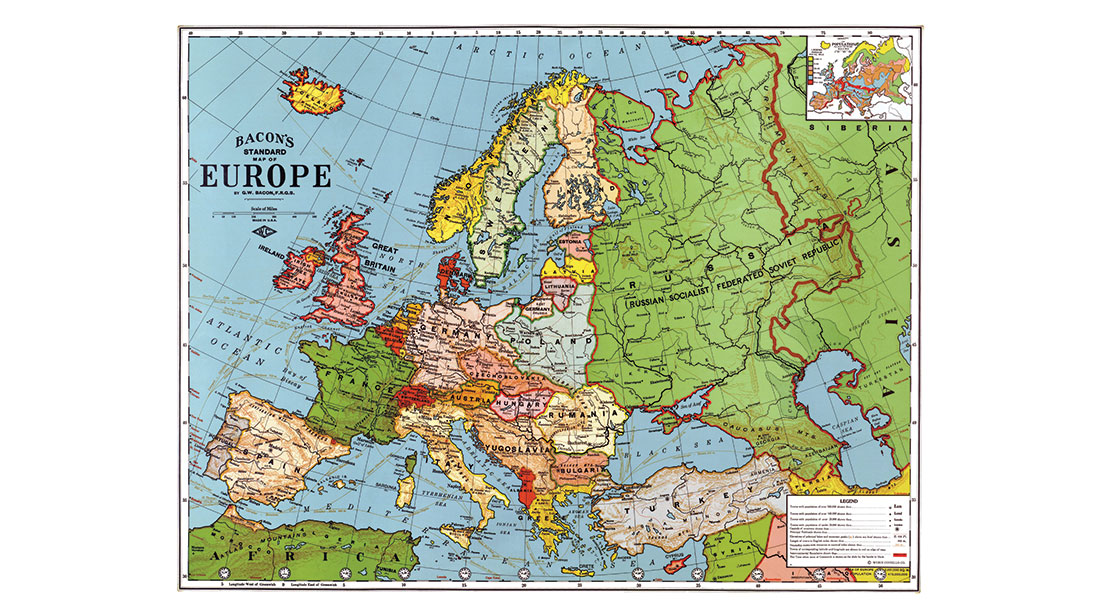Spatial Imaginations of Europe, 1870s-2020s: Ideas, Politics, Economics and Law

Spatial imaginations of Europe are as old as the concept of Europe itself. However, since the 1870s, new dynamics ensued which changed the very nature of how Europe’s spatiality could be imagined and pursued. First, rapid technological and economic globalisation underpinned by European imperialism meant that the entire globe was now strung together via trade, new modes of communication and accelerated travel. Second, intense inter-state and imperial competition was carving up this space and driving Europe towards an existential crisis, which culminated in two world wars and its cumbersome recovery. Europe went from expansionist conceptualisations of political, economic and legal spaces to projects of internal cohesion under the protective umbrella of the United States. The other half was swallowed up by the Soviet Empire. Third, after the end of World War I, Europe (re)appeared as a space in its own right in geopolitical, legal and geoeconomic imagination and planning. At its core lies a taxonomy that places all lands and seas on the face of the earth in specific geographic spaces and lists them in a hierarchical order of importance. Fourth, the late 1800s saw the rise of new modes of multilateral and international organisation, and Europe became and still is a hotbed of such ideas and a veritable laboratory of institutionalised cooperation, the foremost example being the European Union.
In today’s Europe, we are acutely aware that spatial imaginations of Europe are multifarious, contested, ideologically diverse, and envision very different connections with the outside world. Indeed, it seems more pertinent than ever to consider the longer history of spatial imaginaries of Europe, rooted in ideational, political, economic, and legal realities. We stand at a crossroad, where not only the European Union, but the European continent as a geopolitical space, is reinvented, resisted and retained by multiple, more or less organised forces that draw upon the historical lessons of what Europe was, never became or could have been.
This conference seeks to take stock of the antecedents, roots, emergence and sometimes models of spatial imaginations of Europe; to probe their ideational, political, economic and legal manifestations; and to historicize their contested genealogies and relationships with each other. It does so through a prism inspired by global history, which sees space (a) as a product of inter-relationships, (b) created through practice and articulation, and (c) a non-fixed result of historical processes.
Monday 8 December
South Campus, Auditorium 4A-0-69
| 09:00-09:15 | Welcome and Opening Remarks Mogens Pelt, Marine Pierre, Morten Rasmussen and Haakon A. Ikonomou |
| 09:15-10:15 |
Keynote 1 (open to the public) Stuart Ward (University of Copenhagen and Harvard University): From Britons to Britishers: Mapping a Global Imaginary |
Room 8A-4-35
| 10:30-11:15 | Panel 1 – (2×10 min presentations + 20 min. Q&A + 5 min. break/ change)
Chair: Haakon A. Ikonomou (University of Copenhagen) |
| 11:15-11:45 |
Panel 2 – (2×10 min presentations + 20 Q&A)
|
| 11:45-13:15 |
Lunch break |
| 13:15-14:00 | Panel 3 – (2×10 min presentations + 20 min. Q&A + 5 min. break/ change)
Chair: Marine Pierre (University of Copenhagen) |
| 14:15-15:15 | Panel 4 – (3×10 min presentations + 30 Q&A)
Chair: Morten Rasmussen (University of Copenhagen) |
| 15:15-15:30 | Coffee break |
South Campus, Auditorium 9A-3-01, Alf Ross Auditorium
| 15:30-16:30 | Keynote 2 (open to the public)
Iver B. Neumann (Fridtjof Nannsen Institute, FNI): Russia's Europe 1870-2025: Hated, Loved, Hated, and so it goes |
Restaurant Guldsmeden, Gullfossgade 4
| 19:30- | Conference dinner |
Tuesday 9 December
South Campus, room 8A-4-35
| 08:30-09:15 | Panel 5 – (2×10 min presentations + 20 min. Q&A + 5 min. break/change)
Chair: Mogens Pelt (University of Copenhagen) |
| 09:30-10:15 | Panel 6 – Politics 2 (2×10 min presentations + 20 min. Q&A + 5 min. break/change)
Chair: Haakon A. Ikonomou (University of Copenhagen) |
| 10:30-10:45 | Coffee break |
| 10:45-11:30 | Panel 7 – (2×10 min presentations + 20 min. Q&A + 5 min. break/ change)
Chair: Mogens Pelt (University of Copenhagen) |
| 11:45-12:30 | Panel 8 – (2×10 min presentations + 30 Q&A)
Chair: Marine Pierre (University of Copenhagen) |
| 12:30-13:00 | Lunch break (Lunch is delivered to 8A-4-35 – take it with you to the keynote venue if time is scarce) |
South Campus, Auditorium 9A-3-01 Alf Ross Auditorium
| 13:00 - 14:00 | Keynote 3 (open to the public)
Madeleine Herren (University of Basel): Connected at the margins of imperialism? Vladivostok, London and the network of global shipping |
| 14:00- | Thank you, and brief concluding remarks Mogens Pelt, Marine Pierre, Morten Rasmussen and Haakon A. Ikonomou |
Contact
Please write to CEMES and INNER_LEAGUE coordinator Emil Eiby Seidenfaden for more information.
Map of South Campus
View directions.
View on map of the Faculty of Humanities - South Campus.
View map of South Campus (pdf).
